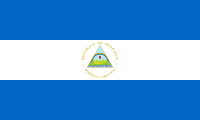Flag of Nicaragua
| Flag of Nicaragua | |
|---|---|
 |
|
| Vexillological symbol : |
|
| Aspect ratio: | 3: 5 |
| Officially accepted: | August 27, 1971 |
The flag of Nicaragua almost corresponds to the original flag of the Central American Federation in 1823 , which in turn is based on the flag of Argentina . The flag of Nicaragua was officially established on August 27, 1971 in its current form as a blue-white-blue stripe flag with the national coat of arms in the center.
In addition to Nicaragua, the flag of the Central American Federation was a model for the nations of Honduras , Costa Rica , Guatemala , and El Salvador . It had the following meaning:
- The white stripe symbolizes the connection between North and South America
- Blue represents the Pacific Ocean and the Caribbean Sea that surround the land bridge .
Historical flags of Nicaragua
The flag history of Nicaragua began on August 21, 1823 with the introduction of the flag of the Central American Confederation . After leaving the confederation on April 30, 1838, the blue-white-blue flag was continued. Presumably the Confederation coat of arms continued to be shown in the center. There are sources that report a separate Nicaraguan one - similar to the one adopted in 1854 - which was used instead of the Union coat of arms.
The following years in Nicaragua were marked by constant revolutionary unrest that lasted practically until the end of the 19th century. This was also noticeable in the use or non-use of national flags. Around 1852 a white-yellow-red flag with a single green volcano in the center is said to have been used. This may have been the "harbinger" of a radical flag change that took place on April 21, 1854. The conservative wing chose a yellow-white-mother-of-pearl flag as a new variant, a special version of which was also used as a trade flag. In 1858, however, under the presidency of Tomás Martínez Guerrero, the traditional blue-white-blue flag was officially returned.
However, other political camps continued to show yellow-white-mother-of-pearl colors, and from 1873 this was again the most widely used national flag. Another change in design is said to have taken place between 1889 and 1893, adding a red stripe to the blue and white stripes like in the flag of Costa Rica . It is unclear whether this flag was actually used as the national flag. In 1893 there was a return to blue-white-blue during a revolt. This flag also formed the basis for the version of the flag of the "Central American Greater Republic" (Republica Mayor de Centro América), which was hoisted in 1896, later known as the "United States of Central America" (Estados Unidos de Centro América). Between November 1, 1898 and November 30, 1898, a new variant was shown which, despite the only three member states Nicaragua, El Salvador and Honduras, depicted five stars or volcanoes, the one in memory of the Central American Confederation of 1823 with the additional members Guatemala and Costa Rica were retained. After the dissolution of this federation of states, the flag from 1896 was probably used until finally on September 4, 1908 the blue-white-blue flag was finally determined as the national flag of Nicaragua. The exact color scheme and the aspect ratio were determined in 1971 together with the national anthem Salve a ti, Nicaragua .
literature
- W. Smith, O. Neubecker: The signs of the people and peoples: Our world in flags and flags . Reich Verlag Luzern, 1975, ISBN 3-7243-0115-4
Web links
- Flag of Nicaragua on FOTW (English)










